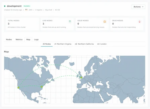The open-source PostgreSQL database project reached version 9.0 today, with the inclusion of highly anticipated streaming replication and hot-standby capabilities topping the list of feature enhancements.
Simon Riggs, lead contributor to the hot standby feature, and CTO of PostgreSQL training and services company 2ndQuadrant, said that “efficient, low-latency streaming replication protects your data better, while hot standby significantly reduces total cost of ownership.” He said that in proprietary database products, this capability can cost thousands of dollars to add on.
Other key enhancements include an upgrade to the upgrade-in-place security feature and 64-bit Windows support for better performance. Version 9.0 has an unprecedented number of major new features, which the PostgreSQL Global Development Group said is due to the accelerating growth of the contributor community over the past year.
Bruce Momjian, a senior database architect with PostgreSQL database provider EnterpriseDB and author of “PostgreSQL: Introduction and Concepts,” said three factors came into play around the database project’s growth. The first is the poor economy, which is forcing companies to reconsider large database software purchases.
Second is uncertainty surrounding MySQL, another leading open-source database that Oracle acquired when it closed its purchase of Sun Microsystems in January. But Momjian asserted that “Postgres is more feature-rich and reliable than MySQL, so the switch also is [from] people doing database migrations to Postgres that they knew they would have to do eventually anyway.”
Finally, the new features in 9.0 are addressing the few remaining ease-of-use problems that have existed, such as easy replication, in-place upgrades, and others. “We kind of know what big features people are waiting for, and for 9.0, we had additional manpower (because of our popularity) that allowed us to deliver much of that in one release, which is why this release is getting so much attention,” Momjian added.
PostgreSQL has more than 20 years of engineering behind it, and it has emerged as a leading alternative to commercial SQL databases since the European Commission declared the database is robust enough to serve as an open-source alternative to Oracle databases, including MySQL. The Oracle acquisition of Sun was held up for a time amid fears that Oracle would shut down the MySQL open-source database project and leave users without another enterprise-ready open-source choice.






